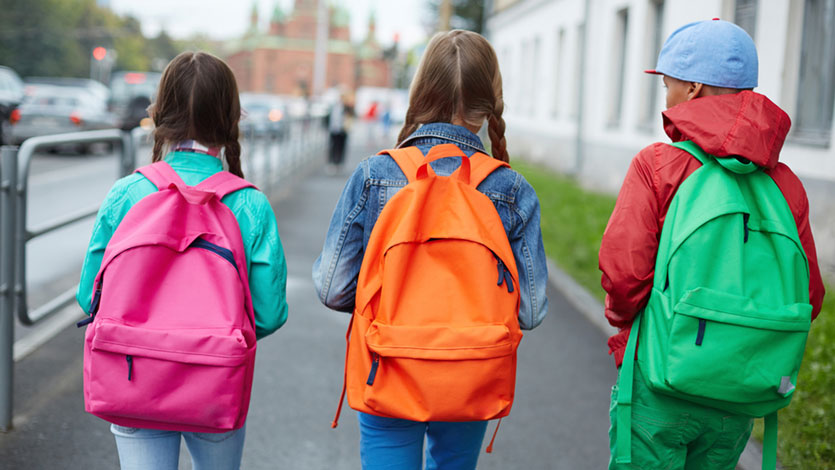Oct 28 2016.
views 813Our everyday normal school bag has indeed evolved over the years. Where once school going children enjoyed carrying their books in beautifully crafted leather satchels or briefcases passed down from generation to generation, the children of today opt for flashy trendy backpacks. With multiple compartments, easy to use zips as opposed to buckles and instantaneously cementing your social standing on the “cool” factor scale, with the backpack carried, it is understandable to see how the ordinary backpack has become the established mode by which children carry their school books.
The Backpack is indeed a better option for when worn correctly the weight of the backpack is evenly distributed on the most strongest muscles of the body, the back and the abdominal muscles. But what has also unfortunately changed is the amount of books a child carries. Despite the proper support given, a backpack when filled to the brim and carried for long periods of time can cause serious strain on the back.

Effects of a backpack on a child's body
As the child places the heavy backpack on his or her back, the weight naturally pulls the body backwards, to compensate for this the child bends at the hips or arches the back. This can cause the spine to compress unnaturally and thus results in sprains on the shoulders, neck and back. Medical experts say children should carry backpacks that weigh no more than 10 to 20 percent of their body weight to avoid lower back pain and associated problems. Once your child has put in the numerous books, pencil cases, other stationary and school lunches the weight in a backpack can reach up to about 4 kilos or more. During periods of rapid growth, adolescents’ spines are changing and it’s a good idea to be careful about increasing stress on the lower back, advises medical experts. This is especially true for young people who also play sports that can extend the back, like gymnastics, ballet, synchronized swimming just to name a few.
Other problems associated with heavy backpacks
In addition to the weight issue there are also other hindrances caused with heavy backpacks:
1. Some children like to carry their backpacks on one shoulder either because they find it easy or for simple vanity purposes. Either way this causes the bearer to lean to wards one side, resulting in severe neck and shoulder pain.
2. Large and heavy backpacks take up space in school aisles, or can hit others in busy corridors.
3. Children have gotten hurt from tripping over large or bulky backpacks and even from ones falling on them.
4. Children do carry heavy backpacks with difficulty, especially if they quite small in stature therefore quickly moving between classes, up and down stairs will prove dangerous, with many tripping and falling trying to juggle the heavy weight.
What can schools do to help their students?
Children carry heavy backpacks because they are compelled too by their schools. Subjects demand that specific books be brought everyday. Here are a few suggestions as to how schools can help students in the backpack struggle.
1. Organize a locker system where children can safely leave their books, therefore not requiring heavy books to be brought everyday.
2. Teachers should take a stand on making sure the children bring only the necessary books for that day's lessons rather than all.
3. Request the children to bring one book per subject rather than multiples. Some schools go so far as to ask children to have certain books like reading or spelling for example always in their bags, this is not a good idea since the children are carrying additional unnecessary weight.
4. Maybe have a paperless system, where the teacher has the “heavy” textbook in class on a screen for the whole class to see and the children just have to bring their notebooks. Also a project for the future would be to have complete paperless form of studying on both ends. Where the student's notes and textbooks are all stored on a laptop or tab.
What's the right backpack for you?
These are all issues to be looked at and analyzed as to how feasible it is to be implemented in the future. In the meantime children still have to carry their heavy backpacks and so it would be prudent to choose your backpack wisely. Here are some helpful suggestion:
1. Whilst younger children might have options of bringing their books in wheeled in school bags, older children will still opt for backpacks, therefore choose one that perfectly fits your child's size.
2. Make sure the height of the backpack extends from approximately 2 inches below the shoulder blades to waist level, or slightly above the waist. In this way adequate support is there.
3. Make sure the shoulder straps are well padded and instead of causing strain on the shoulders will be comfortable and bearable.
4. Usually all back packs come with a hip belt, this helps alleviate strain on the lower back and excessive pressure on the neck and shoulders.
5. Carefully pack your backpack, with the heaviest items closest to the child's back and balance the rest of the bag-pack.
Comments from parents

“The heavy backpacks affect their spine and alignment. Also they're experiencing shocker and back pain and need physio at times” - Inoka

“In my child's school there is a locker system present, but the lockers are situated inconveniently away from the classroom making it impossible for the child to go retrieve the books in the time given when they change classes. Some teachers also except the child to bring all the books for a subject, my daughter's does History, which has three heavy textbooks which she has to carry each day”. - Tushani

“My daughter is hunched, doctor thinks it's the school bag, I would feel better if the schools' introduced lockers where the children could safely keep their books overnight” - Anisa

“Children are facing many psychological problems. Few of the parents come to know about the problem of their child in the form of disturbed child or angry child but mostly problem of a child goes unnoticed. Child can only carry 10 to 15 % of his/her body weight. But it seems that they carry much more then that in form of their school bags everyday to their schools. Not only that so many children are facing headache, ligament tear etc.” - Shobidarshani

“Heavy backpacks can be harmful for kids postures. It can result in many back and posture related problems.The heavy textbooks and folders they carry can result in the kids complaining of neck,shoulder and back pains. Its important they carry a sturdy bag that will give the back good support and showing them the correct way to carry the bag is also important. School too can help with this if they provide a locker facility.” - Shihara
The concerns of parents are plentifold, for they see the immediate effects on their children. A child is in school for almost nine months of the year, and spend nearly eight hours in class. Along with their bag packs they do carry lunch boxes, lunch bottles, sports bags and other necessities. Going to school should not be an uncomfortable experience, our children are there to learn and we must help them do that without any hindrances. It is imperative that schools' take a stand on adopting correct backpack etiquette.

“The lumbar spine of a student shall experience a significant shear force at the time of carrying backpack .When the books are placed incorrectly the weight can pull a child backward, and to manage the weight, the child may bend forward at the hip or arch at the back, which damages the central nervous system. An impact in the spine can cause various health issues in the central nervous system and also the breathing pattern gets triggered. A child must carry 10% to 12% of their body weight,” - Vyasah Kalyanasunderam, Chief Yoga Instructor, Astanka Yoga Mandir & Indian Cultural Center
0 Comments